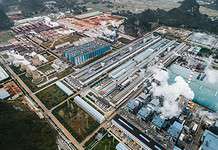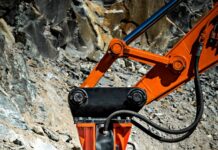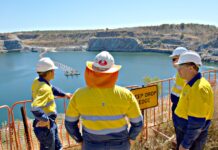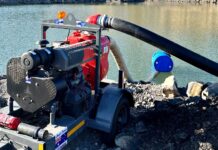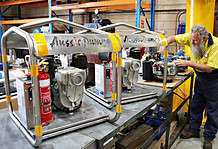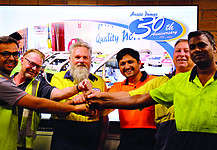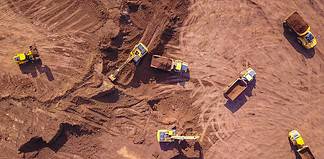THE recovery of gold using cyanide in pulp or leach is the industry standard for most gold mining producers.
However, the use of cyanide comes with many direct and hidden costs and its continued use is drawing more and more scrutiny from mining commissions, environmental regulators and proximal communities around the world.
There are several alternatives to cyanide leaching already on the market but these can often be suited to particular ore types and gold particle size and may not be as economical or effective as cyanide in every application.
In June 2019, Clean Mining launched a new cyanide-free gold processing solution.
This innovative, cost-effective process replaces cyanide with a safer, less hazardous chemical reagent, thiosulphate.
This inorganic compound helps dissolve fine gold out of ores into a solution, which can then be recovered through further processing.
Unlike cyanide-based and other reagent methods such as the carbon-in-pulp or amalgamation method, the technology doesn’t require the addition of acids, lime, oxygen, chlorine, high temperature or pressure vessels.
Effective and scalable
This revolutionary process uses thiosulphate, in conjunction with innovative plant technology, to achieve gold extraction at levels and returns that have been proven at an industrial scale.
The cyanide-free plant is scalable and can operate without a tailings dam.
Each solution is customised and can be scaled to suit site infrastructure, ore grade, metallurgical profile and the client’s operating and capital budgets.
Clean Mining offers the flexibility to design a very small micro plant right through to the largest of scales.
Once the gold is liberated the chemical process is the same, and Clean Mining’s solution can scale up or down to achieve feasibility.
This solution makes clean gold production a reality for miners of all sizes and scales, without the need for a large team of specialist consultants and project managers.
Background: Testing and Trials
The solution was developed by Australia’s national science agency, the Commonwealth Scientific and Industrial Research Organisation (CSIRO), over more than a decade.
After years of product development and refinement, Clean Mining’s parent company, Eco Minerals Research Limited, partnered with CSIRO to build the first demonstration processing plant to test the technology at an industrial scale in Menzies in the Goldfields region of Western Australia.
The success of the trial, in 2017-18, proved the technology could work successfully at an industrial scale.
The trial achieved gold liberation at a p80 greater than 300 microns, with leach reagent consumption at 1.6 kg/t – the majority of the consumption is entrained loss with the tails.
Unlike cyanide, the reagent chemicals do not deteriorate.
The reagent consumption is only limited by the level of solid/liquid separation to recapture and reuse the leach solution.
In the case of the demonstration project, the separation was not optimised to the full potential.
However, if miners choose to include Clean Mining’s dewatering process option in their plant design, both the chemicals and water reclaimed from the leach tailings are recyclable.
With an estimated moisture content of between 8pc to 15pc in most dry stack leach tailings, that provides great potential for both thiosulphate compound and water recycling within each operation.
The trial also involved the production of the first gold ingots and gold product sales to a Western Australian jeweller, who has reported a solid demand for the Clean Gold product.
In 2019, CSIRO transferred the technology to Clean Mining.
Environmental benefits
Cyanide is not only a toxic chemical, which presents risks to workers and communities involved in the supply and management of the product, it is usually expelled into tailing dams.
The larger the operation, the larger the tailing dam and the larger the costs of management and rehabilitation – not to mention the risks of potential chemical leaching into the environment or dam failure.
The reality is that cyanide is becoming more of a liability for miners every day.
Regulations associated with cyanide are even holding back development of some major global gold deposits.
Jurisdictions in China, Eastern Europe, Argentina, Central America, the United States and Africa have either implemented, or plan to implement, bans on cyanide use.
In October 2019, Sudan’s Council of Ministers issued directives calling for an immediate halt to the use of toxic mercury and cyanide in mining operations.
Mercury use is rife in many African countries as artisanal miners use it for extraction of both hard rock and alluvial gold, with little or no regard for its impact on their own health or the local environment.
In many areas artisanal miners use shared crushers and trommels to process their ore, so there is an opportunity for them to also share this new technology with the right support from local mineral commissions.
Existing users of cyanide will claim that is safe, but “safe” is an inaccurate term as cyanide is always toxic.
What cyanide users mean by “safe” is that risk has been mitigated, as a result of complex rules, regulations, processes, engineering design, reporting, and so on. However, it costs a lot to mitigate risk.
Costs
It would take a very comprehensive study to identify all of the costs that can be reduced or eliminated by using thiosulphate but, once this data is available, Clean Mining hopes it will be a driver for cyanide-based miners to actively consider a conversion of their leaching circuit away from cyanide.
For smaller miners who simply can’t afford a cyanide-based plant, Clean Mining’s solution provides a processing option with a lower entry cost that is also safer to operate.
Their leaching plant is smaller in scale than an entry level CiP/CiL plant that uses cyanide, which means it has a lower capital cost.
With the cost to invest in an entry level CiP/CiL plant upwards of US$20m, the solution potentially removes the cost barrier that prevents many miners from proceeding to production, as well as supporting small-scale artisanal miners and co-ops.
Traditional plants that require a tailing dam also incur massive compliance costs, which adds to the total size and scale of the processing plant to deliver a viable return to the mining company.
Clean Mining believes this is a cost barrier to more than 90pc of miners.
Modular and mobile
Clean Mining’s solution can also be made in modular components and be mobile, therefore, it is scalable and the plant can be relocated to a number of mine sites as required.
For miners keen to utilise the technology, the setup process is simple and eliminates the need for a hoard of specialist consultants and project managers.
For larger miners, the costs of cyanide compliance are so embedded in their cost structures that it is a very complex process to do a “whole of mine life” cost comparison at this point in time.
However, the compliance and rehabilitation costs associated with cyanide use alone are significant and include:
- regulatory compliance requirements
- compliance with the International Cyanide Management Code
- environmental social governance (ESG) compliance and reporting
- stringent health and safety management, including PPE
- personnel costs associated with regulatory compliance
- additional capital and operating costs associated with plant design and process design to mitigate the risks of cyanide contamination to personnel and the environment
- ancillary chemicals and acids required to facilitate the cyanidation process
- contingency plans and infrastructure required in the event of a spill, leakage or disaster
- freight restrictions and costs for transporting dangerous goods
- high storage compliance costs
- monitoring and reporting
- insurances
- tailings dam infrastructure and management
- cyanide destruction chemicals
- rehabilitation bonds
- rehabilitation and monitoring requirements after mining has ceased
As Clean Mining’s leach tailings are not toxic, the solution does not require a tailings dam for chemical destruction, as is required with cyanide.
That saves miners the capital cost of building a tailings dam and the operating costs associated with maintaining, running, monitoring, reporting, and rehabilitating/remediating the dam and destroying the cyanide.
There are also specific instances where tailings dams are either too risky or are not possible, like areas of high rainfall, high seismic activity, proximity to dense populations, highly sensitive environmental areas, low water resources, high regulatory compliance or mountainous terrain, so our solution addresses all of these issues by eliminating that need.
Dry stack tailings option
Clean Mining’s solution offers miners the option of producing dry stack tailings (DST) by including a dewatering and chemical recovery process.
Clean Mining’s leaching reagent chemicals are reusable, so there is an immediate operating cost benefit if miners choose to recover the chemicals and water used.
In addition, the dewatering process produces DST that can be repatriated or stored.
As a result, a mine that uses Clean Mining’s technology has a smaller footprint, lower environmental risk, reduced water use and chemical recycling options.
Mining communities are safer and less likely to interrupt the mine’s freedom to operate and, therefore, the operation has a lower risk profile to insure and presents a more attractive opportunity for shareholders to invest in a responsible mining operation.
Interest and progress to date
Several months after launching the product, Clean Mining is in active negotiations with a number of miners to build plants in Australia and Asia, and similar interest is stemming from other areas of the world.
Eco Minerals Research’s gold processing plant in Menzies is the first mining operation to use the technology.
The demonstration plant has a 50t per day capacity and this is currently being upgraded..
In Australia, Clean Mining is currently targeting small to medium scale miners that don’t have the financial means to acquire an entry level cyanide plant or don’t want to use cyanide.
Until now this industry segment has not had access to a small scale, cheaper leaching plant.
The aim is to open up the 85pc of gold tenements in Australia that are currently inactive.
Clean Mining is also targeting countries and regions that cannot use cyanide and tailings dams due to regulatory bans or other circumstances.
Clean Mining is not limited to a specific scale of mining in these locations and have already been approached by some of the largest international mining companies.
However, given cyanide-based circuits cannot simply be ‘upgraded’ to use thiosulphate, the company is currently focused on junior and artisanal miners who can most benefit from the installation of a new mobile and scalable plant.
An initial small-scale plant may also be beneficial to companies seeking to commence bulk sampling as proof of commercial viability to management and shareholders.
Once successful, the modular nature of the thiosulphate plant enables it to be scaled up according to capital availability and permitted throughput.
Conclusion
Industry, regulators, environmental organisations, miners and local communities have been searching for a non-toxic solution to gold processing and Clean Mining now offers that solution.
Thiosulphate is a game changer for the gold industry.
Clean Mining anticipates that there will be an ultimate realisation in the industry that there is no need to use cyanide anymore.
They believe the mining sector must, and can, do things differently – and options like Clean Mining’s cyanide-free gold processing is part of the solution.
Clean Mining is committed to clean production and is also working to eliminate mercury from the extraction process.
They also promoting their Clean Gold accreditation as a key driver of awareness and visibility of clean production opportunities.
Source:
Clean Mining.
08 6117 5812




